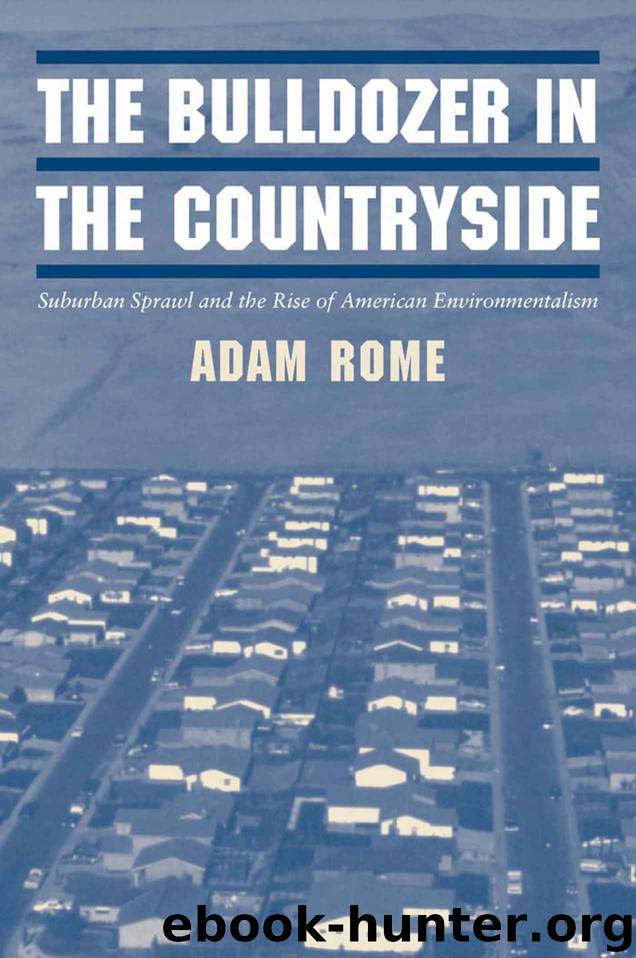The Bulldozer in the Countryside (Studies in Environment and History) by Rome Adam

Author:Rome, Adam [Rome, Adam]
Language: eng
Format: epub
Publisher: Cambridge University Press
Published: 2001-04-16T00:00:00+00:00
5
Where Not to Build: The Campaigns to Protect Wetlands, Hillsides, and Floodplains
* * *
“The great issue in planning is not where to build,” planner S. B. Zisman wrote in 1965, “but where not to build.”1
With that dictum, Zisman summarized a dramatic change in the planning profession. For decades, the principal task of urban planners was to decide where to allow residential, commercial, and industrial development. What areas should be restricted in use, and what areas should be open to all forms of building? On planning and zoning maps, a different color represented each type of land use, while open space – as yet unzoned and undeveloped – was typically white. But the explosive growth of suburbia after World War II changed the way planners thought about the white spaces on city maps. Year after year, as cities consumed more land, people began to appreciate the value of open space. “The chief lesson to be learned,” Zisman argued, “is that open space is a functional land use – open space is not the left-over land, or the vacant land, the unused land or the waste land. It is of an equal order of consideration with any kind of development.” That meant that planners now needed to ask a new question. What sites were more valuable as open space than as subdivisions, shopping centers, or factories?2
The answers were not obvious. The more people thought about the where-not-to-build question, the longer the list of valuable open spaces became. Yet three kinds of places stood out. In the decades after World War II, developers built to an unprecedented extent on wetlands, steep slopes, and floodplains, and in time the construction of tract housing on all three kinds of land became controversial.3
The arguments against wetland, hillside, and floodplain development came from people in a variety of fields, including geography, ecology, civil engineering, geology, hydrology, and landscape architecture. Their critiques had much in common. In each case, the argument against development depended on a new understanding of the costs of disregarding natural processes. If we continued to build insensitively, the critics argued, we would lose a number of gifts of nature, from clear streams to valuable wildlife habitat; we also would increase the likelihood of losses from “natural” disasters, especially floods and landslides. We needed instead to “design with nature.”4
Download
This site does not store any files on its server. We only index and link to content provided by other sites. Please contact the content providers to delete copyright contents if any and email us, we'll remove relevant links or contents immediately.
How to Do Nothing by Jenny Odell(3232)
A Forest Journey by John Perlin(3026)
The Plant Messiah by Carlos Magdalena(2881)
Babylon's Ark by Lawrence Anthony(2619)
The ESV Study Bible by Crossway Bibles(2502)
Energy Myths and Realities by Vaclav Smil(2436)
Fatal Storm by Rob Mundle(2171)
Abbey in America by Murray John A(2049)
Witness Tree by Lynda V. Mapes(1887)
Brokeback Mountain by Annie Proulx(1780)
Client Earth by James Thornton(1731)
Shadows on the Gulf by Rowan Jacobsen(1716)
Coming Back to Life by Joanna Macy(1684)
Cosmos by Carl Sagan(1679)
Water Rights and the Environment in the United States by John Burch(1641)
Mycelium Running: How Mushrooms Can Help Save the World by Paul Stamets(1635)
Ten Billion by Stephen Emmott(1609)
The overachievers by Robbins Alexandra(1528)
Ecological Intelligence by Daniel Goleman(1496)
